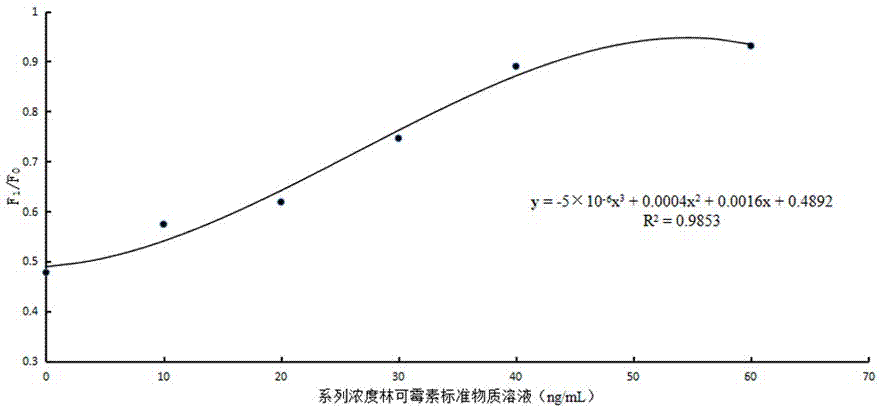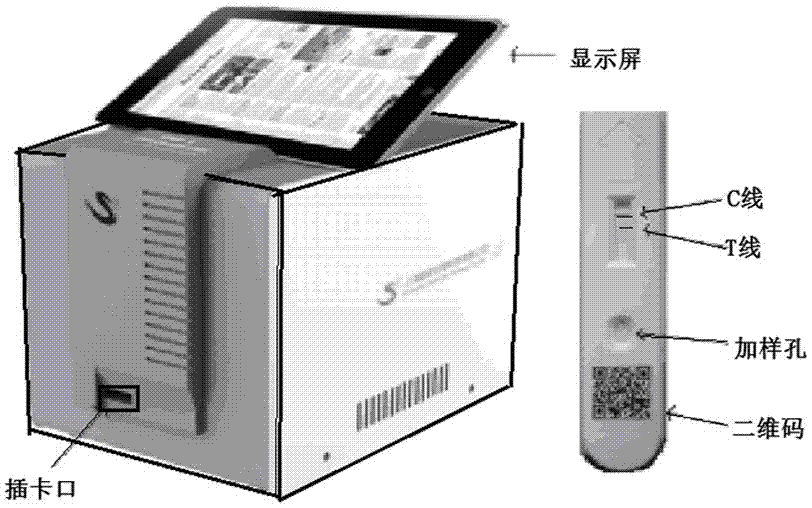Method for detecting lincomycin in milk based on background fluorescence quenching-immunochromatography
A lincomycin and fluorescence quenching technology, applied in measurement devices, analytical materials, biological tests, etc., can solve problems such as poor reproducibility, cumbersome processing, and inability to perform quantitative analysis, and achieve short reaction time and high sensitivity. , the effect of easy operation
- Summary
- Abstract
- Description
- Claims
- Application Information
AI Technical Summary
Problems solved by technology
Method used
Image
Examples
Embodiment 1
[0015] Example 1, the method for determining lincomycin in milk based on background fluorescence quenching-immunochromatography is carried out according to the following steps: the first step is to enter the lincomycin standard curve equation and name into the two-dimensional code system Make a lincomycin two-dimensional code, and then paste the lincomycin two-dimensional code on the two-dimensional code on the lincomycin test strip to get the lincomycin test card; the second step, Take 200 μL of the sample to be tested into a small test cup immobilized with gold-labeled antibody, mix well, pipette 100 μL dropwise into the sample hole on the lincomycin test card, and perform chromatography at room temperature for 10 minutes; the third step is to layer After the analysis, insert the lincomycin detection card into the card slot of the fluorescent immunoassay analyzer, click the test sample, and the display screen of the fluorescent immunoassayer will display the name of the sampl...
Embodiment 2
[0016] Example 2, the lincomycin standard curve equation is obtained by the following method: the first step, the configuration of lincomycin stock solution, take lincomycin standard substance, and use PBS to make 1 μg / mL lincomycin Solution, to obtain lincomycin stock solution; the second step, the configuration of lincomycin series concentration standard solution, the lincomycin stock solution is sequentially made into 10ng / mL, 20ng / mL, 30ng / mL with standard milk samples , 40ng / mL, and 60ng / mL lincomycin series solutions to obtain lincomycin series concentration standard solutions; in the third step, take 200 μL of standard milk samples and 200 μL of lincomycin series concentration standard solutions until gold is immobilized. In the small test cup labeled with the antibody, draw 100 μL dropwise into the sample hole on the lincomycin test strip after mixing well, and perform chromatography at room temperature for 10 minutes; the fourth step is to test the lincomycin Insert t...
Embodiment 3
[0017] Example 3, as an optimization of the above example, the standard milk sample is a milk sample that does not contain lincomycin after testing.
PUM
 Login to View More
Login to View More Abstract
Description
Claims
Application Information
 Login to View More
Login to View More - R&D
- Intellectual Property
- Life Sciences
- Materials
- Tech Scout
- Unparalleled Data Quality
- Higher Quality Content
- 60% Fewer Hallucinations
Browse by: Latest US Patents, China's latest patents, Technical Efficacy Thesaurus, Application Domain, Technology Topic, Popular Technical Reports.
© 2025 PatSnap. All rights reserved.Legal|Privacy policy|Modern Slavery Act Transparency Statement|Sitemap|About US| Contact US: help@patsnap.com



